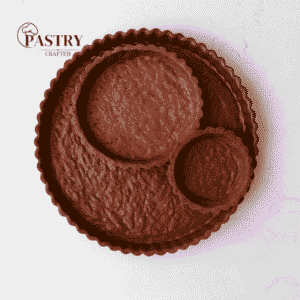
Sweet cocoa paste
There are lots of recipes for chocolate tarts, but they often use a classic sweet pastry base. It's all very well, of course, but I find that a sweet pastry with cocoa really adds something extra! So here's a recipe to remedy the problem.It's an easy recipe, but as is often the case with pastry recipes, it's made for two tart shells. You can divide it up if you feel like having some fun with half an egg, but you should know that it freezes very well.You can also use the leftovers, or all of it, to make chocolate shortbread.
Ingredients
- Cocoa-sweetened dough :
- 90 g powdered sugar
- 25 g unsweetened cocoa powder
- 120 g softened butter
- 2 g salt
- 30 g almond powder
- 1 egg
- 210 g flour type 55
Instructions
Cocoa pastry :
- You can make this recipe either in your food processor fitted with the leaf (the flat whisk) or by hand in a salad bowl.
- If your butter is too cold and too hard, you'll need to work it a little. It needs to have a “creamy” texture for the dough to be homogenous.
- Sift together the powdered sugar and cocoa powder.
- Pour the butter, powdered sugar, cocoa, salt and almond powder into your bowl. Mix at slow speed to avoid foaming the butter.
- Add the egg and continue mixing. If your dough is not very homogeneous, don't hesitate to use a maryse or a horn to scrape the bottom of your bowl.
- Add the flour and knead at medium speed. It's best to knead as little as possible and stop as soon as the flour is incorporated into the mixture, even if it doesn't form a nice ball of dough.
- The more you mix, the crumblier your dough will be, the harder it will be to work, and the more fragile it will become once cooked.
- Place the dough in cling film. Crush the ball with the palm of your hand to make as flat a disk as possible.
- This will ensure that your dough is compact and roughly in the right shape to roll out, and will chill faster in the fridge.
- Leave your chocolate dough to rest in the fridge for an hour.
- Flour your work surface and your dough, then roll it out, taking care to give it a 1/8 turn between each roll. This ensures that there's always enough flour underneath, and that the dough glides smoothly and doesn't stick to your work surface. It also helps to keep the basic round shape (who hasn't ended up with a square after rolling out their dough?).
- Roll your dough out on your rolling pin and unroll it onto your circle or tart tin. If it breaks, don't panic - the advantage of sweet dough is that it will come together again when baked.
- Take the edge of the pastry that's sticking out of the circle and slide it over, pressing it down with the fingers of your other hand so that it sticks tightly against the edge of the circle. If you push the dough from the inside, it may tear.
- Then, using your fingers, gently push the dough into the circle at a right angle. You've just done what we call “darkening” a tart!
- Finally, with a small knife, cut off the excess pastry by sliding the blade against your circle or tart tin.
- Finally, you'll need to let your tart rest once more in the fridge. This isn't essential, but it will prevent the pastry from shrinking or the edges from falling off during baking, so don't skip this step.
- Preheat your oven to 170°C fan-assisted, prick your tart with a fork to prevent air bubbles from forming during baking and put your pastry in the oven for 15 min.
Notes
Tips and advice to remember :
Once the flour has been incorporated, you need to work the dough as little as possible to prevent it from becoming crumbly, so stop your mixer as soon as the mixture is smooth.To make the rest easier, your dough should have a round, flat shape once filmed.
If your dough breaks, tears or has holes in it, don't panic: just fill it in with a little dough, making sure that the thickness remains the same throughout. During baking, the dough will knit back together, and once it's done, you'll hardly notice a thing.
It's important to respect the last pause so that the dough doesn't shrink during baking.
If you don't want to prick the bottom of your tart, you can use a perforated silicone mat placed on your oven rack. It allows air to pass underneath the pastry and prevents it from puffing up during baking.
Tried this recipe?Let us know how it was!
I’m Chef Mimo, a passionate pastry chef with over 17 years of experience in the world of fine desserts. I specialize in French-style entremets, refined cakes, and creative chocolate work. Pastry is not just my profession—it’s my lifelong passion. Through PastryCrafted.com, I love sharing my recipes, techniques, and inspirations with anyone who dreams of mastering the art of pastry. Whether you’re a curious beginner or a seasoned pro, you’re welcome in my sweet world.


1 Comment
[…] Sweet cocoa paste […]